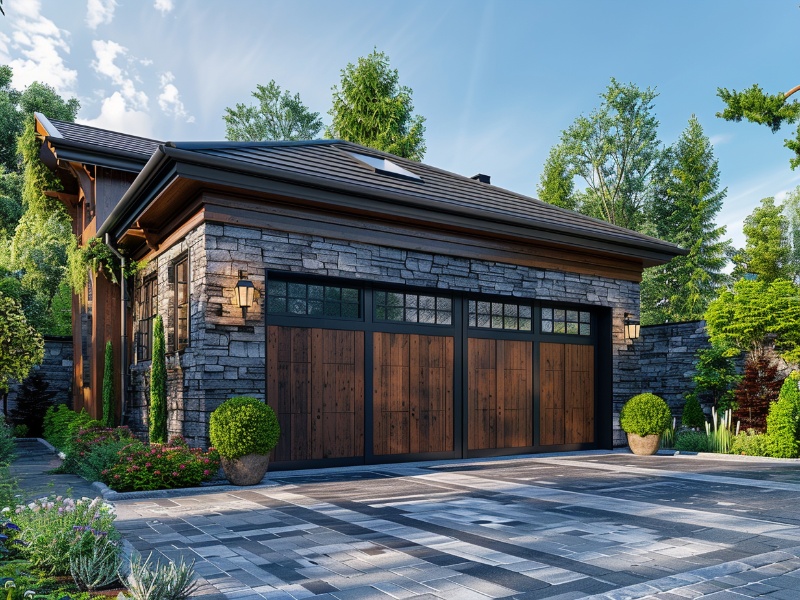Garage door weatherstripping plays a vital role in preserving the efficiency and functionality of a garage.
This guide delves into the significance of weatherstripping for garage doors, outlining its purpose and the various types accessible.
It elaborates on the selection process for suitable weatherstripping, details the installation procedure, and offers insights on maintenance and replacement techniques necessary for safeguarding the garage against environmental elements.
Understanding the Purpose of Weatherstripping
Weatherstripping plays a vital role in home improvement, serving as a crucial seal for your garage door that improves energy efficiency, weatherproofing, and overall comfort.
This makes it a key component in preserving your home’s exterior and safeguarding against diverse weather conditions.
What is Weatherstripping?
Weatherstripping is the process of sealing openings, such as doors and windows, to prevent air, water, and other elements from infiltrating a structure, thereby establishing a weatherproof seal.
This vital practice plays a pivotal role in regulating the interior climate of a building by reducing heat loss in colder months and minimizing excess heat gain during warmer seasons.
By creating a secure barrier around doors and windows, weatherstripping also assists in lowering energy expenses by enhancing the overall efficiency of heating and cooling systems.
Properly implemented weatherstripping not only improves comfort levels within a space but also guards against moisture penetration, which can result in issues like mold growth and wood deterioration.
In essence, weatherstripping represents a cost-effective solution that contributes to the durability and structural soundness of buildings by shielding them from adverse weather conditions.
Why is it Important for Garage Doors?
Weatherstripping is of utmost importance for garage doors as it serves to insulate the garage effectively, preventing drafts and offering protection against external weather conditions.
These functions contribute significantly to the overall energy efficiency and comfort within the garage.
The creation of a tight seal around the edges of the garage door by weatherstripping is pivotal in maintaining a consistent temperature inside the garage.
This improved insulation not only enhances the comfort of activities conducted within the space but also aids in regulating energy consumption.
Consequently, homeowners can benefit from reduced energy costs owing to the diminished requirement for continuous heating or cooling to counteract temperature fluctuations resulting from poor insulation.
Moreover, the enhanced defense against drafts and weather elements provided by weatherstripping serves to prolong the lifespan of the garage door by minimizing its exposure to harsh external conditions.
Types of Weatherstripping for Garage Doors
In the realm of weatherstripping for garage doors, various types are accessible, each presenting distinct advantages and weatherproofing solutions tailored to address diverse requirements and preferences.
Rubber Weatherstripping
Rubber weatherstripping is widely recognized for its exceptional durability and effectiveness, frequently employed as a bottom seal for garage doors to offer robust protection against drafts and external elements.
In various weather conditions, rubber weatherstripping demonstrates its resilience by enduring extreme temperatures and retaining the flexibility to seal any gaps along the garage door.
Its durable nature ensures prolonged operational efficiency, rendering it a cost-efficient solution for homeowners. By establishing a secure seal at the bottom of the garage door, rubber weatherstripping proficiently obstructs cold drafts, moisture, and debris, thereby upholding a comfortable and clean environment within the garage.
This heightened weather resistance not only enhances insulation within the interior space but also contributes to reducing energy expenses by averting heat dissipation during colder periods.
Vinyl Weatherstripping
Vinyl weatherstripping is widely recognized for its exceptional flexibility and durability, rendering it a superior option for the purpose of energy-efficient sealing and protection against various weather elements.
Its inherent pliability enables it to adapt to the irregularities of garage door frames, thereby establishing a secure seal that effectively blocks drafts and moisture infiltration.
This characteristic proves particularly advantageous in the preservation of a consistent indoor temperature and the reduction of energy expenditures. Moreover, vinyl weatherstripping exhibits notable resistance to wear and tear, ensuring prolonged functionality with minimal upkeep requirements.
By averting heat loss during winter and preventing the escape of cool air in summer, this material not only bolsters energy efficiency but also fosters a more comfortable and sustainable living environment.
Brush Weatherstripping
Brush weatherstripping is comprised of bristles affixed to a metal strip, serving the purpose of effectively mitigating drafts and sealing apertures surrounding garage doors.
This weatherproofing solution is recognized for its adaptability, as it readily conforms to irregular surfaces and contours present on garage door frames.
By virtue of the brush bristles, a secure seal is formed, thereby preventing drafts while also acting as a barrier against dust, insects, and moisture intrusion.
Consequently, the utilization of brush weatherstripping contributes to a cleaner and meticulously regulated garage environment.
The installation process for this form of weatherstripping is straightforward and uncomplicated, typically necessitating rudimentary tools such as a screwdriver or adhesive.
This ease of installation renders brush weatherstripping a favored option among individuals inclined towards do-it-yourself projects, seeking to enhance the energy efficiency and overall comfort of their garage spaces.
Choosing the Right Weatherstripping for Your Garage Door
Selecting the most appropriate weatherstripping for your garage door requires a thoughtful evaluation of multiple factors.
This process ensures that you choose a weatherproofing solution that aligns with your specific requirements and enhances the overall functionality and security of your garage.
Factors to Consider
When considering weatherstripping options for your garage door, it is important to take into account various factors including the characteristics of the material, the type of weatherstrip, and its effectiveness in regulating temperatures and minimizing noise levels.
Different materials possess differing levels of durability and resistance to weather conditions. Rubber weatherstrips, for instance, are recognized for their flexibility and ability to create effective seals, while vinyl alternatives are noted for their ease of installation and maintenance.
The type of weatherstrip utilized, whether it be adhesive-backed, bulb, or V-shaped, significantly influences its capacity to seal gaps and diminish air infiltration.
Efficient weatherstripping not only aids in regulating indoor temperatures but also in reducing external noise, thereby contributing to a more serene environment.
Emphasizing durability ensures that the weatherstripping remains functional for an extended period, necessitating less frequent replacements and maintenance efforts.
Installation Process for Weatherstripping
The process of installing weatherstripping on your garage door can be simplified with the appropriate tools and methods, offering a do-it-yourself-friendly method to improve your garage’s weather resistance and energy efficiency.
Step-by-Step Guide
For the proper installation of weatherstripping on a garage door, it is advisable to adhere to the following step-by-step guide in order to attain an optimal seal and improve weatherproofing measures.
- Firstly, it is crucial to select the appropriate weatherproofing materials for the task at hand, such as silicone caulk, adhesive weatherstripping, and a weatherproof sealant. It is imperative to have the requisite tools readily available, including a utility knife, measuring tape, and a caulking gun.
- Commence the process by meticulously cleaning the surface where the weatherstripping is to be affixed to eliminate any dirt or debris. Proceed to accurately measure and cut the weatherstripping to suit the dimensions of the garage door, ensuring a snug and precise fit.
- Methodically apply the adhesive weatherstripping along the door’s edges, exerting adequate pressure to create a secure seal.
- Finally, conclude the task by sealing any gaps or seams with silicone caulk to provide additional protection against adverse weather conditions.
Maintaining and Replacing Weatherstripping
The conscientious upkeep and prompt replacement of weatherstripping are imperative to ensure its efficacy in safeguarding your garage door and preserving its energy efficiency and weatherproofing functionalities.
Tips for Longevity
To prolong the lifespan of weatherstripping, routine maintenance and timely inspections are imperative to prevent air leakage and uphold effective protection.
Cleaning plays a pivotal role in the maintenance of weatherstripping.
Accumulation of dirt and debris over time can compromise the sealing capability.
Utilizing a mild detergent and water for regular cleaning of the weatherstripping is recommended.
Additionally, conducting inspections to identify signs of wear and tear, such as cracks or gaps, holds significance.
Should any damage be detected, it is advised to promptly replace the weatherstripping to ensure optimal performance.
By actively maintaining your weatherstripping, you not only mitigate energy loss but also enhance the overall energy efficiency of your residence.
This, in turn, leads to reduced utility expenses and a more hospitable living environment.
Signs It’s Time for Replacement
Recognizing the indications that suggest the necessity to replace weatherstripping is essential for preserving an adequate seal and guaranteeing home comfort and protection from various weather conditions.
A common signal that weatherstripping may require replacement is observable wear and tear.
As time progresses, weatherstripping can develop cracks, become brittle, or wear out, thereby compromising its functionality.
Another indicator is drafts; the sensation of airflow around doors or windows typically indicates that the weatherstripping is failing to seal properly.
Monitoring any escalation in energy expenses can function as a warning sign.
Deteriorated weatherstripping permits the escape of heat or cool air, resulting in heightened energy usage.
Timely replacement is imperative to sustain a secure seal, improve energy efficiency, and ensure that your residence remains comfortable throughout all seasons.
Frequently Asked Questions
1. What is garage door weatherstripping?
Garage door weatherstripping refers to the material or seal that is placed around the edges of a garage door to prevent outside elements, such as water, air, and dirt, from entering the garage.
2. Why is weatherstripping important for garage doors?
Weatherstripping is important for garage doors because it helps to maintain the temperature inside the garage, prevents damage to the door and its components, and improves energy efficiency.
3. What types of weatherstripping are available for garage doors?
There are various types of weatherstripping available for garage doors, including rubber, vinyl, and brush seals. Each type has its own benefits and can be chosen based on personal preference and climate.
4. When should weatherstripping be replaced?
Weatherstripping should be replaced when it becomes cracked, brittle, or damaged. It is also recommended to replace weatherstripping every few years to ensure maximum effectiveness.
5. Can weatherstripping be installed by myself?
Yes, weatherstripping can be installed by yourself if you are comfortable with DIY projects. However, it is recommended to seek professional installation for a proper and secure fit.
6. How do I maintain garage door weatherstripping?
To maintain garage door weatherstripping, regularly inspect for any damage and clean it with a mild detergent and water. It is also important to keep the weatherstripping free of debris and ensure proper alignment with the door.

